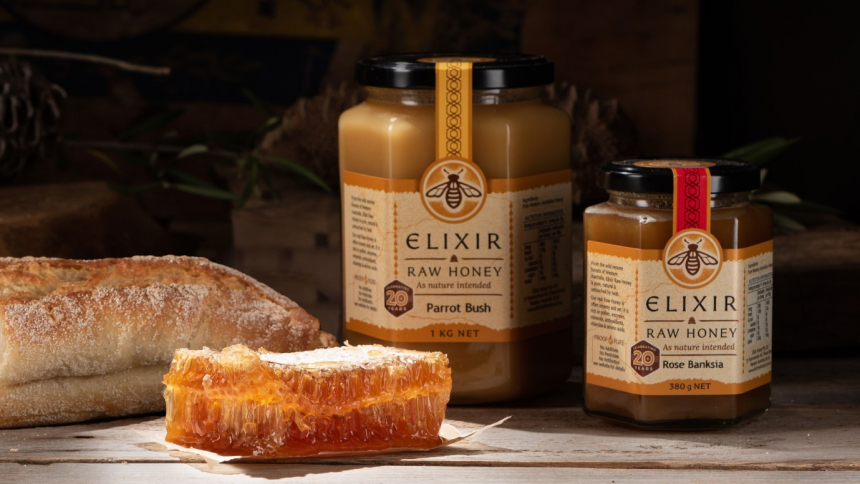
If you knew how hard it is to make the nectar of the gods, you might appreciate it even more. Let’s get up close and sticky with the sweet stuff.
It keeps bees very busy
The only insect-derived food, honey is the fruit of mindboggling labour. Bees fly more than 88,000km, dropping by about two million flowers, to produce a mere 450 grams of the sweet stuff. Each bee visits about 50 to 100 flowers in one trip, bringing back nectar to regurgitate into the honeycomb hive to feed their young and protect themselves in the winter.
A bee only makes a fraction of a teaspoon of honey in its lifetime – you need a dozen bees to make a whole teaspoon. When you consider the average bee only lives between six and eight weeks, that’s a lot of work in a short amount of time.
Luckily, they work wonderfully as a collective, providing they have a queen bee. Without one, they get irritable and aggressive and don’t seem to know what to do. With a strong leader, a hive of about 60,000 worker bees can generate 25-30kg of honey in a season.
It has been around forever
Honey dates to prehistoric times, with cave paintings in Spain showing people foraging for the sweet stuff at least 8000 years ago. Though reports of edible honey being found in ancient Egyptian tombs have been disputed, honey does have an incredible shelf life.
Honey and objects covered in honey have been found preserved for centuries, with scientists attributing the natural preservative to an enzyme in the stomach of those magical bees. It suppresses the growth of bacteria, which is why pure honey sealed tightly in a jar lasts so long.
The beeswax created by the clever bees to form cells for honey storage has also been used since prehistoric times, including as the first plastic, a lubricant and wood polish, and to make candles. Ancient Egyptians even mixed it with minerals to create eye make-up.
Honey is still a popular ingredient in cosmetics because of its natural properties. You’ll find it in everything from lip balms to moisturisers and hair care products.
It comes in many flavours
We are not talking about anything that might be added when honey is processed but the natural taste of unadulterated honey. It can taste very different – from fruity and floral to nutty to spicy – depending on the region the bees call home and the flowers they visit. The colour of the honey also varies with the floral palate.
Swan Valley Honey spins gold from bees who spend their short lives foraging in our pristine bushland. Each batch tastes as different as the flowers the busy bees visit. The honey isn’t heat treated, either, to keep all the nutrients locked in.
Western Australia has become well-known for honey with distinctive bush flavours, such as the popular jarrah. Forest Fresh sources raw and natural honey from the Southern Forests, while Elixir Honey collects its liquid gold from remote, pristine forest and bush. The taste varies with the seasons but are always distinctly local and delicious.
Wescobee Honey, which has been making honey for almost 100 years, sources its bounty from bees that roam the karri and jarrah forests in the South West, as well as desert areas. Piesseful Bees produces a range of jarrah, marri and white gum-flavoured honey, sourced from bees roaming around Perth and the South West.
It’s good for you
The healing power of honey has been known for centuries. With antimicrobial and antibacterial properties, it has been used to help heal minor burns and cuts, as well as to soothe sore throats and aid digestion.
While it only has small amounts of vitamins and minerals, honey contains antioxidants such as flavonoids and phenolic acids that are believed to help prevent cell damage that can lead to premature ageing and type 2 diabetes.
The closer it is to nature intended, the healthier the honey. Look for products labelled raw, 100 percent natural, unfiltered or organic and make sure there aren’t any added preservatives or other nasties.
It is very versatile
If you’ve largely kept your honey consumption to spreading a liberal lash on toast or as a substitute for sugar in hot drinks, you are missing out.
Honey can be used in almost everything, whether sweetening a dish, balancing spices or glazing your favourite meat (it’s a real winner with ham).
This honey-baked quince with walnuts makes the most of winter ingredients, while banana honey bread goes down a treat at any time of day. For a decadent entree, try this fabulous fig and honey-baked camembert.
Just remember, honey is a carbohydrate high in sugar (glucose and fructose) so should be consumed in moderation.